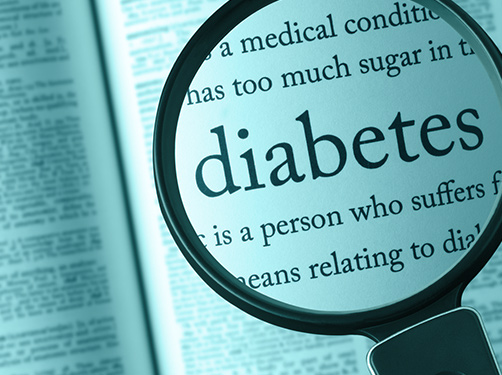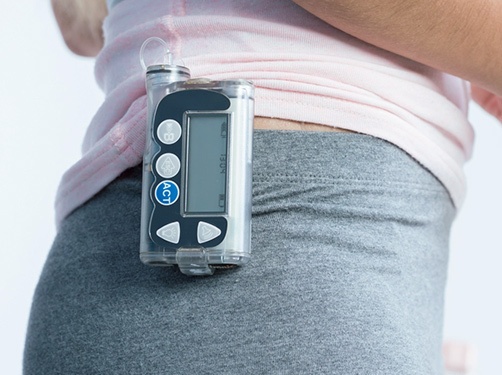Heat and diabetes
Scientific support: Prof. Dr. Baptist Gallwitz
Addressing climate change and knowing, for example, how the body reacts to permanently high temperatures, is especially important for people with diabetes. This is because the expected increase in periods of high temperatures is more problematic for those with diabetes than for people with a healthy metabolism. This is especially true for older people with diabetes.

Contents
1. Climate change: What people with diabetes should know?
Extreme temperatures can be more problematic for those with diabetes than for people with a health metabolism. Older people with diabetes are especially at risk.
They often have a reduced feeling of thirst meaning that under hot conditions they are at risk of not drinking enough fluids. This leads to increased blood sugar levels resulting in more sugar being excreted via the urine, which causes a further increase in the required fluid intake. Poor blood sugar control can compound this problem. The water balance in the body becomes increasingly out of sync. This can result in metabolic imbalances and functional disorders affecting the kidneys, heart, and other organs.
Good to know:
The information portal www.klima-mensch-gesundheit.de (Link in German) from the Federal Center for Health Education (BZgA in German) provides quality-assured and independent information on climate change, heat, and health.
Video: Heat when suffering from diabetes – How the body reacts
This video is available with English subtitles.
2. Reduced heat tolerance
There are additional physiological factors that can reduce heat tolerance for all type of diabetes. However, they do not play as major a role in the health-related consequences of high temperatures in those with diabetes as the reduced feeling of thirst in older people with the disease.
People with diabetes also react later, slower, and weaker to heat than those with a healthy metabolism. This is because their physiological ability to adjust to heat can be impaired by the disease and work in a limited manner. The reason for this is the reduced activity of the sympathetic nerve pathways that are responsible for the regulation of sweat glands and blood vessels.
The results in an impairment of wet heat exchange via sweating and the dry exchange of heat via the skin, which dissipates heat via dilation of the blood vessels. Peripheral nerve damage and severe obesity (adiposity) further reduce the ability to adjust to heat. Obesity negatively affects the body’s ability to dissipate heat because the body surface area has become smaller in relation to body weight. Also, heat dissipation via fatty tissue is slower than via muscle tissue.
Another problem for insulin-dependent people is that the increased blood flow resulting from the dry heat exchange causes insulin to be distributed throughout the body faster. This increases the risk of low blood sugar. Furthermore, heat often reduces appetite, which can also lead to low blood sugar.
But the opposite can also be true: People with type 2 diabetes that is inadequately managed with blood sugar reducing tablets can develop high blood sugar levels, which increases the risk of dehydration. Also, concomitant and secondary diseases, such as high blood pressure and cardiovascular disease, can become worse in high temperatures. The risk for a heat-induced heart attack associated with diabetes is increased due to poor blood supply to the heart.
Good to know:
The following factors increase the risk of reduced heat tolerance in people with diabetes:
- Old age
- Obesity
- Injecting insulin
- Concomitant and secondary diseases
Video: 6 tips for the heat for people with diabetes
This video is available with English subtitles.
3. What should people with diabetes bear in mind on hot days?
- Drink enough fluids
Drinking enough fluid is the most important thing! This advice applies especially to older people with diabetes. At least 1.5 liters per day is recommended, ideally in the form of water or other calorie-free drinks, such as unsweetened tea. Drinks with added sugar and alcohol should be avoided. In the event of symptoms, such as dizziness or fatigue, older people in particular should seek medical attention immediately.
- Store insulin correctly
Those who require insulin should ensure that they have an adequate supply and that it is stored correctly at 2 to 8 degrees. The pen currently in use should not be stored at temperatures exceeding 30 degrees, i.e., not on the window ledge or in direct sunlight. Insulin is very sensitive to high temperatures and becomes inactive when exposed to temperatures above 30 degrees. Take note: Insulin cannot be frozen as it will become inactive.
- Keep measurement devices and test strips away from sunlight
Extreme temperatures can also negatively affect blood sugar measurement devices and test strips. Blood sugar measurement devices, test strips, insulin pumps, and other diabetes therapy aids should be stored at normal room temperature and protected from direct sunlight as far as possible. The utensils should also not be refrigerated, as cold temperature can lead to incorrect readings.
- Adjust insulin and medication dosages
In hot weather, those who are insulin- or tablet-dependent should talk to their physician to discuss their blood sugar-reducing tablets dosage and possible adjustment. The of other medications, such as blood pressure-reducing medication, should also be checked.
- Regular blood sugar level testing
Generally, on hot days, those with diabetes should test their blood pressure and blood sugar levels at least twice daily.
- Other than that, they should follow the same advice on hot days as people with a healthy metabolism?
Even in summer, sufficient exercise and physical activity remains essential. On particularly hot days, physical activity should take place in the early morning or late evening to avoid the midday sun. When outside, it is important to protect your head, skin, and eyes from UV rays.
4. How can I live in a more climate-friendly and healthy way?
In everyday life, there are many ways to reduce your CO2 footprint. The most effective measures for CO2 footprint reduction can be found in the Big Points from by the Competence Center for Sustainable Consumption. We have summarized them in this article. The beauty of having a sustainable lifestyle with regular physical activity and a healthy diet is: You can prevent the complications of diabetes while also protecting the climate and environment.
Sources:
Geissel, W.: Hitzewellen sind für Diabetiker besonders bedrohlich. In: ÄrzteZeitung, 2021 (Letzter Abruf: 26.04.2022)
Ärzteblatt online: Diabetologen warnen vor erhöhter Sterblichkeit durch Klimawandel. (Letzter Abruf: 26.04.2022)
Bundeszentrale für gesundheitliche Aufklärung: Neue Broschüre „Menschen in Bewegung bringen“. Nationale Empfehlungen für Bewegung und Bewegungsförderung in Kurzform. (Letzter Abruf: 26.04.2022)
Deutsche Diabetes Gesellschaft: Hitzewelle in Deutschland: Bei Menschen mit Diabetes steigt das Risiko für einen Herzinfarkt. (Letzter Abruf: 26.04.2022)
Edmonds, C. J. et al.: Dehydration in older people: A systematic review of the effects of dehydration on health outcomes, healthcare costs and cognitive performance. In: Arch Gerontol Geriatr, 2021, 95: 104380
As of: 08.08.2022







